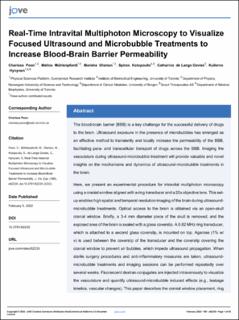| dc.contributor.author | Poon, Charissa | |
| dc.contributor.author | Mühlenpfordt, Melina | |
| dc.contributor.author | Olsman, Marieke | |
| dc.contributor.author | Kotopoulis, Spiros | |
| dc.contributor.author | Davies, Catharina de Lange | |
| dc.contributor.author | Hynynen, Kullervo | |
| dc.date.accessioned | 2022-10-10T12:37:37Z | |
| dc.date.available | 2022-10-10T12:37:37Z | |
| dc.date.created | 2022-03-16T15:20:17Z | |
| dc.date.issued | 2022 | |
| dc.identifier.issn | 1940-087X | |
| dc.identifier.uri | https://hdl.handle.net/11250/3025129 | |
| dc.description.abstract | The blood-brain barrier (BBB) is a key challenge for the successful delivery of drugs to the brain. Ultrasound exposure in the presence of microbubbles has emerged as an effective method to transiently and locally increase the permeability of the BBB, facilitating para- and transcellular transport of drugs across the BBB. Imaging the vasculature during ultrasound-microbubble treatment will provide valuable and novel insights on the mechanisms and dynamics of ultrasound-microbubble treatments in the brain.
Here, we present an experimental procedure for intravital multiphoton microscopy using a cranial window aligned with a ring transducer and a 20x objective lens. This set-up enables high spatial and temporal resolution imaging of the brain during ultrasound-microbubble treatments. Optical access to the brain is obtained via an open-skull cranial window. Briefly, a 3-4 mm diameter piece of the skull is removed, and the exposed area of the brain is sealed with a glass coverslip. A 0.82 MHz ring transducer, which is attached to a second glass coverslip, is mounted on top. Agarose (1% w/v) is used between the coverslip of the transducer and the coverslip covering the cranial window to prevent air bubbles, which impede ultrasound propagation. When sterile surgery procedures and anti-inflammatory measures are taken, ultrasound-microbubble treatments and imaging sessions can be performed repeatedly over several weeks. Fluorescent dextran conjugates are injected intravenously to visualize the vasculature and quantify ultrasound-microbubble induced effects (e.g., leakage kinetics, vascular changes). This paper describes the cranial window placement, ring transducer placement, imaging procedure, common troubleshooting steps, as well as advantages and limitations of the method. | en_US |
| dc.language.iso | eng | en_US |
| dc.rights | Attribution-NonCommercial-NoDerivatives 4.0 Internasjonal | * |
| dc.rights.uri | http://creativecommons.org/licenses/by-nc-nd/4.0/deed.no | * |
| dc.title | Real-time intravital multiphoton microscopy to visualize focused ultrasound and microbubble treatments to increase blood-brain barrier permeability | en_US |
| dc.type | Journal article | en_US |
| dc.type | Peer reviewed | en_US |
| dc.description.version | publishedVersion | en_US |
| dc.rights.holder | Copyright 2022 JoVE | en_US |
| dc.source.articlenumber | e62235 | en_US |
| cristin.ispublished | true | |
| cristin.fulltext | original | |
| cristin.qualitycode | 1 | |
| dc.identifier.doi | 10.3791/62235 | |
| dc.identifier.cristin | 2010287 | |
| dc.source.journal | Journal of Visualized Experiments | en_US |
| dc.relation.project | Norges forskningsråd: 262228 | en_US |
| dc.identifier.citation | Journal of Visualized Experiments. 2022, 180, e62235. | en_US |
| dc.source.volume | 180 | en_US |

